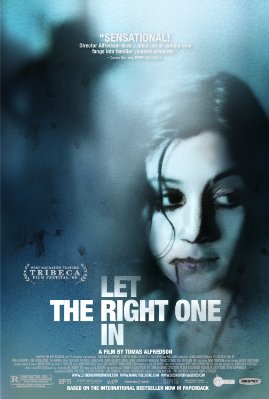
LET DEN RATA COMME IN (LET THE RIGHT ONE IN)
Sweden, 2008, 115 minutes, Colour.
Kare Hedebrant, Lina Leandersson.
Directed by Tomas Alfredson.
An enigmatic title which does not indicate the theme or tone of this quietly mysterious and even sinister film.
Set in a wintry housing estate in Sweden, it begins with snow falling and a young boy looking from a window. There are profiles of others staring into the cold night. The boy lives with his mother, has some contact with his absent father whom he loves. However, he is badly bullied at school and is reserved in his manner. It is not surprising that he makes friends with the young girl next door who has suddenly materialised and is comfortable in his company.
We soon learn what the boy takes longer to discover: that Eli, the young girl, needs to feed on blood to survive. Her mentor brutally kills some students. While the tone of the film is not particularly gory – though it has its moments – this is not your traditional vampire film. For one thing, we know nothing of Eli's origins or why she is in the apartment. She has no relatives and just survives from day to day (or, rather night to night). She has a powerful effect on the young boy who wants to 'go steady' with her. This is the first time that he has experienced anything like this, the new experience of having a girlfriend. It seems that it is the same for Eli.
In the meantime, the boy's mother fusses about him and worries about his behaviour at school. The older adults in the district who tend to resort to a local tavern find that some of their friends disappear and are mystified and upset. The police are investigating the unsolved killings.
The development of the drama is slow-burning. The danger is that the audience is not gripped emotionally but are more like detached observers, admiring the skills with which the writer, novelist John Ajvide Lindqusit, has built up atmosphere, and the director gradually immersing his audience in the moods and action so that it is quite affected by the end – the puzzle of what will happen to the boy and to Eli.
Those of a Jungian persuasion may be tempted, as this reviewer was, to wonder whether everything was really happening in the boy's mind and imagination because of the 'magic realism' episodes and the strange vampiric presence of Eli. She is an anima figure. The film is full of shadow figures: the bullying boys, inadequate parents, the sinister guardian, the strange neighbours, dogs and cats who are terrified when vampires are present. And the final scene...? Is it real, or has the boy finally retreated into his sub-conscious?
1.The novel, the adaptation by the author? The focus on children and family? Loneliness and bullying? The vampire theme?
2.The low-key style, the slow burning, the audience observing, gradually immersed in the atmosphere? The effect?
3.The scenes of violence, the suggestions of violence, the results of violence, increasing towards the end? The role of blood?
4.How real was this story? Actual or in Oscar’s mind? Eli as his Anima? The shadow figures of his parents, the people in the village, the bullies at school? The atmosphere of snow in the suburbs of Sweden? The box in the train?
5.A Swedish film, the Swedish winter, the cold and the dark, the snow and ice, the Stockholm suburb? The contrast with the scenes in daylight? From Eli’s perspective, light and darkness?
6.The neighbourhood, the apartments, the bar, the underpass, the woods, the frozen river? The contrast with the ordinariness of the school, the swimming pool, the picnic and the ice?
7.Oscar, aged twelve, his looking out the window, his initial comments about the pig squealing and getting vengeance? Eli hearing this? His ordinary life, with his mother in the apartment, his absent father yet his love for him, talking on the phone, the outings with him? His imagination? The posters and the decorations in his room? At school, the victim of the bullies, within the group of children?
8.The contrast with Eli, the man watching out for her, his pursuing the student in the woods, hanging him, getting the blood, his escape? Later, accosting the neighbourhood men? His death? Eli as a vampire, no explanation? Her age, as a person, no family? Her needs, the blood? The cat’s reaction? Her listening to Oscar, friendly with him, talking, in the room, sharing? His giving her the Rubik Cube and her solving it? His asking her to go steady, his girlfriend, his explanations? Her desperate need for blood, hidden in the day, her killing? The growing friendship with Oscar, the stronger bond? Ultimately the massacre at the pool? Suggested – rather than seen? Finally in the box in the train?
9.Her guardian, sinister, watching, stalking people in the woods, at night, killing, hanging the bodies, getting the blood? His repeating this with other victims?
10.The old friends in the neighbourhood, gathering at the bar, their talk, the bonds with each other, the friend being killed in the underpass, the burial of the body, the discovery of the body? The children and the ice? The woman and the cats? Her being bitten, in hospital, vampirised?
11.Oscar’s mother, fussing, yet not looking after him well? Upset about what happens at school? His father, the visits, the bond?
12.School, the ordinariness? The bullies, their taunts to Oscar? The leader and his brother? Oscar getting the upper hand and the angry reaction? The picnic, the ice? In the pool, the brother, holding Oscar down in the pool, Eli destroying them?
13.The police investigation?
14.A vampire story, winter, bleak, a mystery, in a mystery world? No explanations?